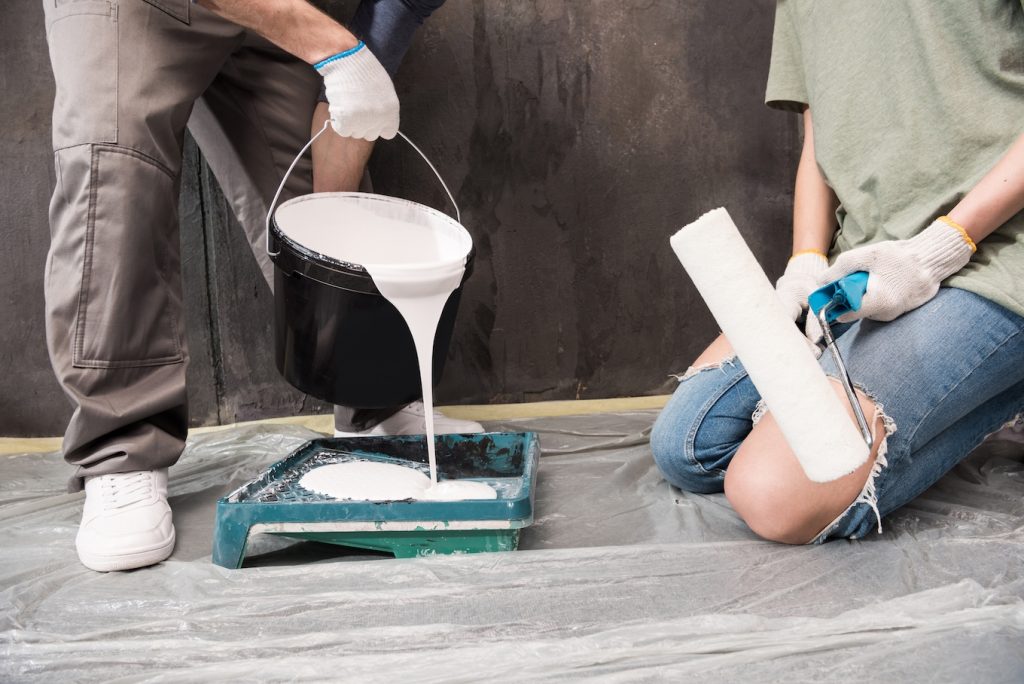If you know you have lead paint in your home, you might be wondering: is it safe to paint over it? The short answer is: sometimes, and only with a certified encapsulant.
Professional lead abatement is often your best bet for completely eliminating the threat of lead exposure. Lead abatement technicians are able to safely contain and remove lead paint from your surfaces without creating a larger lead hazard.
Encapsulating lead paint as an amateur can be risky. In this article, we discuss the dangers of lead-based paint, how to identify lead paint, when you can safely paint an encapsulant over lead paint, and when to call a professional instead. Let’s get started.
The Dangers of Lead Paint Exposure
Lead paint exposure poses significant health risks, especially for young children, who are most vulnerable to its effects. When lead paint deteriorates, it produces dust and chips that can be ingested or inhaled. Children are more likely to ingest lead-contaminated dust and paint chips. This exposure can lead to severe neurological damage, including cognitive impairment, learning disabilities, and decreased IQ. Behavioral issues such as attention deficit hyperactivity disorder (ADHD) and increased aggression are also common among children with elevated lead levels.
For adults, lead exposure is also hazardous. Chronic exposure can result in cardiovascular problems such as hypertension and increased risk of heart disease. Kidney damage and reproductive issues, including reduced fertility and complications during pregnancy, are other serious concerns. Lead can also accumulate in bones, leading to long-term exposure and potential release into the bloodstream during times of stress, such as pregnancy or illness, posing additional health risks.
Moreover, lead poisoning is often insidious, with symptoms not appearing until significant exposure has occurred. Early symptoms, such as fatigue, irritability, and abdominal pain, can easily be mistaken for other conditions, delaying diagnosis and treatment. This makes regular screening and preventive measures, such as removing or sealing old lead paint and maintaining a clean, dust-free environment, crucial in mitigating the dangers associated with lead paint exposure.
How to Identify Lead Paint
To identify lead paint, you can use the following methods:
- Visual Inspection: Look for signs of deterioration such as chipping, peeling, or cracking paint, especially in older buildings.
- Lead Test Kits: Available at hardware stores, these kits use swabs or solutions to detect lead on surfaces. They provide quick, on-the-spot results.
- Professional Inspection: Hire a certified lead inspector or risk assessor who can use specialized tools, like X-ray fluorescence (XRF) analyzers, to accurately detect lead paint.
- Laboratory Testing: Collect paint samples and send them to a certified laboratory for detailed analysis. This method provides the most definitive results.
Taking these steps can help you determine if lead paint is present and take appropriate actions to manage or remove it safely.
Can You Paint Over Lead Paint? The Signs to Know
In short: yes, but only when your lead paint isn’t damaged. It’s safe to paint over lead paint when the existing paint is in good condition, with no peeling or chipping, and the surface is clean and dry. However, if your surface shows damage, we do not recommend trying to paint over the lead.
When Not To Encapsulate
You should not encapsulate lead paint if the paint is already peeling, chipping, or otherwise deteriorating, as encapsulation requires a stable surface to be effective.
Additionally, encapsulation is not suitable for surfaces that experience friction or impact, such as windowsills, doors, and floors, because the constant wear can break down the encapsulant and expose the lead paint.
If the area is prone to moisture or high humidity, encapsulation might fail over time due to water damage. In such cases, it is better to remove the lead paint entirely or consult a lead abatement professional to determine the safest and most effective method for dealing with the lead hazard.
How to Safely Encapsulate Lead Paint
To safely encapsulate lead paint, you’ll need to use a certified encapsulant designed for lead paint, and ensure the area is well-ventilated and free from high friction or impact during the painting process. Regular maintenance and inspections should follow to ensure the encapsulant remains intact.
Safety Precautions & PPE
When encapsulating lead paint, taking safety precautions and using appropriate personal protective equipment (PPE) is crucial to minimize exposure to lead dust and debris. You’ll need to take the following safety precautions while encapsulating lead:
- Work Area Preparation: Seal off the work area with plastic sheeting to prevent lead dust from spreading to other parts of the home. Ensure adequate ventilation by using fans and opening windows, but avoid creating conditions that may disperse lead dust.
- Surface Preparation: Use wet methods to clean surfaces before encapsulation to minimize dust creation. Do not dry sand or scrape the lead paint, as this can release hazardous lead dust.
- Cleaning and Disposal: Use a HEPA vacuum and wet cleaning methods to clean up dust and debris during and after the project. Dispose of all debris, including plastic sheeting, rags, and other contaminated materials, in heavy-duty plastic bags. Follow local regulations for hazardous waste disposal.
You’ll also want to have the following PPE on hand:
- Respiratory Protection: Wear a NIOSH-approved respirator with a HEPA filter to protect against inhaling lead dust.
- Protective Clothing: Wear disposable coveralls or clothing that can be washed separately from regular laundry. This helps prevent lead dust from being carried to other areas. Use disposable shoe covers or designated work shoes that stay in the work area.
- Gloves: Use disposable gloves to protect your hands from lead dust. Change gloves frequently, especially after breaks or handling contaminated materials.
- Eye Protection: Wear safety goggles or a face shield to protect your eyes from dust and debris.
- Hygiene Practices: Avoid eating, drinking, or smoking in the work area. Wash hands, face, and any exposed skin thoroughly with soap and water after completing the work or before breaks. Shower and change into clean clothes immediately after completing the project to avoid taking lead dust home.
By following these safety precautions and using the appropriate PPE, you can minimize the risks associated with encapsulating lead paint and protect your health and the health of those around you.
What Paint Should I Use to Encapsulate Lead?
To encapsulate lead paint, you should use a specialized encapsulant that is specifically designed for this purpose. When choosing an encapsulant, ensure it is certified for encapsulation, follow the manufacturer’s application instructions carefully, and consider consulting with a professional to ensure proper and safe application.
These encapsulants are available in three main types: polymer coatings, epoxy coatings, and cement-like coatings. Polymer coatings are flexible and durable, making them suitable for most indoor surfaces. Epoxy coatings provide a hard, impact-resistant finish ideal for high-traffic areas. Cement-like coatings create a thick barrier and are best for surfaces that may be exposed to moisture or heavy use.
Call a Professional Lead Abatement Team Today
If you’re based in Colorado and in need of lead abatement services, give us a call today at (303) 481-8234. At Mile High Environmental Services, we are an elite team of environmental restoration experts, providing hazard removal for threats such as asbestos and mold.
Fully certified, licensed, and insured, our team provides efficient, thorough remediation and restoration for all types of projects. Contact us today for a free estimate for your lead abatement needs.


